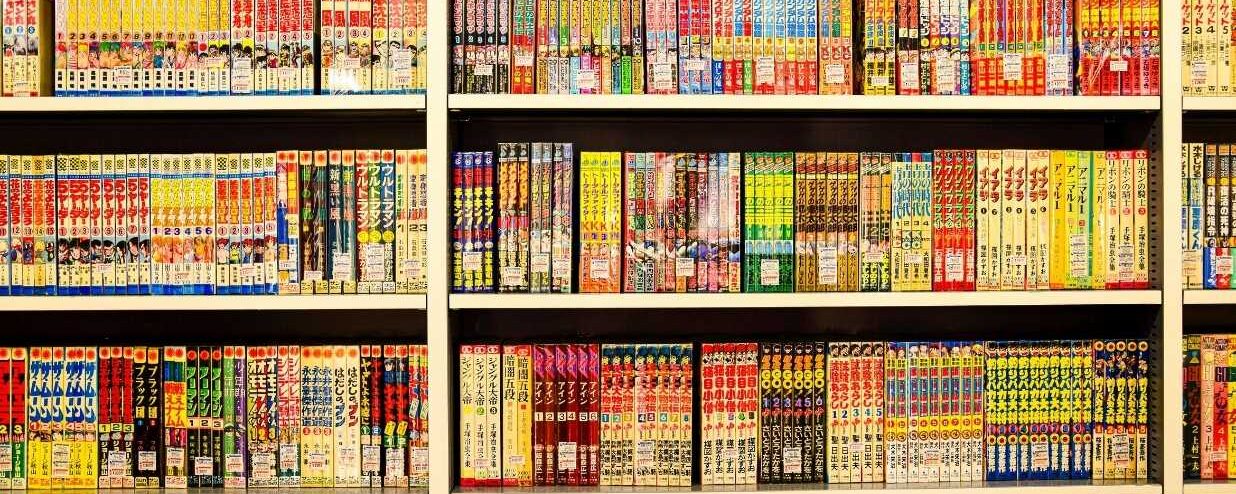For many of us, our love for Japan began with manga, whether it was action-packed cult classics like One Piece or something more niche in the shoujo (genre for young women) comics. So why not turn that passion into a way to learn Japanese? We get it—you might be thinking: Is that even possible? Don’t I need to know a ton of kanji to be able to read manga?
Similar to using anime to learn Japanese, reading untranslated Japanese manga can be a great tool to aid your study. Like anime, it is packed with conversational Japanese while also providing visual aid. The visual artwork helps you understand the context without needing to know every word being said. But the best part about manga is you don’t have to worry about pausing when you miss something.
Whether you’re a fan of manga or looking for a place to start, we will provide recommendations of stories that you can sink into while learning Japanese. We will separate the categories from beginner, intermediate, to advanced. Two birds with one stone, right?
Getting Started with Japanese Manga
Different from Western comic books, manga (漫画) refers to Japanese comic books or graphic novels. It’s a hugely popular form of entertainment in Japan and around the world, covering a wide range of genres, from action, romance, and fantasy to slice-of-life, horror, and even business or cooking.
Can I Learn Japanese with Manga?
Absolutely! Manga can be a fun and surprisingly effective way to learn Japanese, especially if you’re already a fan.
One of the biggest advantages is that many manga include furigana: small hiragana characters written alongside kanji. This helps readers understand the pronunciation without constantly reaching for a dictionary, making it ideal for learners still building their kanji skills.
Since most manga are driven by dialogue, the sentences are usually short and conversational. That means you’ll get exposed to natural Japanese in bite-sized, manageable chunks, unlike dense textbook passages. And unlike anime, there’s no need to pause and rewind. You can take your time, reread tricky lines, and even jot down new vocabulary as you go.
Of course, manga is best used as a complement to your studies. It won’t replace structured learning, but it’s a great way to reinforce grammar, grow your vocabulary, and make studying feel more enjoyable.
Here are a few ways you can learn and read manga:
1. Start off with easier manga, such as slice of life manga
This part is very important and is skipped more often than not. If you are starting from scratch, perhaps Naruto might not be the best starting point. It’s very easy to get excited and try to read your favorite titles, but not understanding any of the language will defeat the purpose of reading in Japanese and having fun doing it. But don’t worry! There are plenty of captivating manga you can read that contain more entry-level Japanese.
2. Find manga with furigana
Most manga written for younger audiences will feature furigana or hiragana written above kanji and sometimes katakana. Since children still can’t read many kanji, manga written for them will have hiragana to help them read through the whole manga.
3. Use the artwork to understand context
Rather than looking up every word you don’t understand, try seeing if you can understand the text based on the visual artwork.
4. Keep your phone handy to translate
If the visuals aren’t enough to understand specific terms, keep your phone or translator handy while reading. There might be one word or so that you need to know to understand the whole context, so don’t be afraid to translate when needed.
The best manga are ones that are interesting and keep you coming back and reading consistently. So at the end of the day, choose based on your preferences. This is also why we tried to vary the genres on this list.
Where to Buy Japanese Manga
Of course, we’re talking about manga in its untranslated form. If you’re living overseas, the most popular manga are likely already translated into your native language—or at least English!
Don’t worry—the great news is that whether you’re in Japan or abroad, there are plenty of convenient ways to get your hands on manga. In general, if you live overseas, you can probably get manga through online stores like Amazon.
Where to buy manga online
- Amazon Japan: Ships internationally for many titles. Some manga also provide a digital version, which you can download on Kindle!
- CDJapan: Specializes in Japanese media, including manga.
- BookWalker: Official digital manga store, great for ebooks.
- Kinokuniya: International bookstore chain with an online shop.
Where to buy manga in Japan
If you’re in Japan, it’s the opposite: most manga are naturally in Japanese, giving you the perfect chance to practice the language. Local bookshops and major department stores usually have manga sections.
- Book Off: Popular secondhand bookstore chain.
- Tsutaya: Large bookstore with a good manga selection.
- Kinokuniya: Found in major cities and airports.
Best Manga To Learn Japanese For Beginners
1. Blue Box (アオのハコ)

- Genre: Sports, Romance
- JLPT Level: N5 – N4
- Length: 20 volumes
Blue Box is a beloved romantic-comedy sports manga by Koji Miura, serialized in Weekly Shonen Jump since April 2021. Blue Box follows Taiki, a high school badminton player, who develops feelings for Chinatsu, a basketball star.
This manga is a blend of innocent romance and gripping sports genres, making a captivating read you can’t put down. The sports aspect of the manga is extremely inspiring and emotionally satisfying as you see the characters progress their skills and, of course, their relationships with each other.
The Japanese texts are easy to understand and do not dive too deep into sports-related terms. So, it makes for a fun, action-packed story that you can fly through while picking up practical Japanese.
2. Shirokuma Cafe (しろくまカフェ)
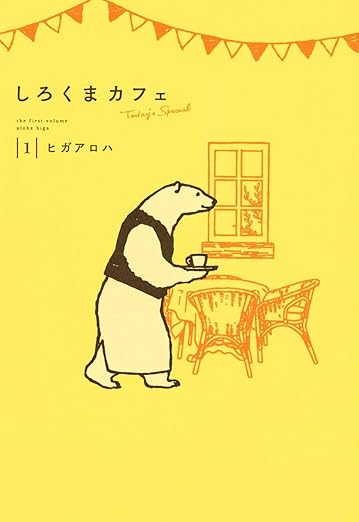
- Genre: Slice of Life, Comedy
- JLPT Level: N4 & above
- Length: 5
This light-hearted manga follows a lazy panda who befriends a polar bear running a cafe. Filled with puns and a delightful atmosphere of anthropomorphic animals, this quirky manga is an amazing introduction to how to use Japanese with more humor and figurative speech.
However, the puns do make references that some of us might not understand. So, keep your phone handy to look up certain words or puns that might fly over your head!
Buy Shirokuma Cafe Volume 1 on Amazon
3. Flying Witch (ふらいんぐうぃっち)

- Genre: Comedy, Supernatural, Slice of Life
- JLPT Level: N4 – N3
- Length: 14 volumes
This is a light-hearted, comedic, fantasy manga that follows the daily life of a witch who has just moved to rural Aomori Prefecture. This manga is essentially if Studio Ghibli’s Kiki’s Delivery Service meets more comedy. The Japanese language is pretty easy to read while still being quite fun, and will definitely make you giggle.
There’s just one character who might be tricky to understand because of his strong dialect, but don’t worry, even the main character struggles with him! Luckily, another character usually “translates” his lines into standard Japanese, so we can follow along easily.
Buy Flying Witch Volume 1 on Amazon
4. Yotsuba&! (よつばと!)
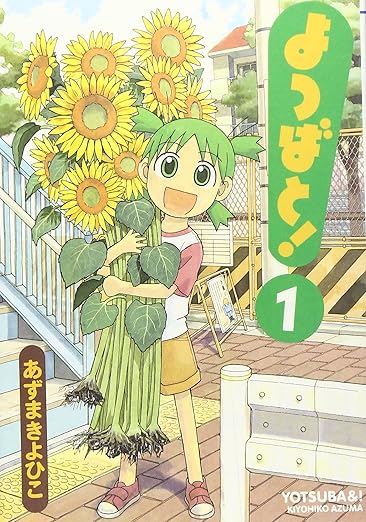
- Genre: Slice of life
- JLPT Level: N5 – N4
We couldn’t possibly exclude Yotsuba&! on this list. It’s one of the most popular manga for Japanese learners. The manga follows a 5-year-old girl whose curiosity takes her on different adventures and has her asking about everything. Through the lens of this child, we are able to pick up new vocabulary along with her.
There are a few things to keep in mind: the manga does sometimes have colloquial or even purposely incorrect grammar and words meant to be played for humor. A complete beginner might miss this or mistakenly believe everything written is correct.
Another thing to consider is that since the story follows a young child in her daily life, it won’t have any crazy action, drama or deep plots. It’s a very simple, light-hearted story. This may or may not be your cup of tea.
Buy Yotsuba&! Volume 1 on Amazon
5. Coro Coro Comics (コロコロコミく)
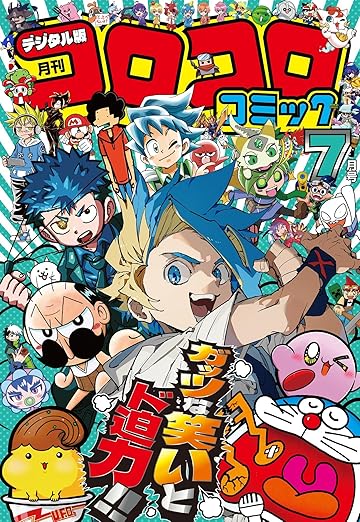
- JLPT Level: N4 – N3
- Length: Around 750 pages each, the magazine is ongoing
This is not really a manga series but rather a manga magazine releasing new issues monthly. It features stories from popular franchises such as Doraemon, Pokemon, and Detective Conan. This magazine is intended for children mostly below junior high, so the Japanese is at a much easier level. You can find a variety of fun stories from titles you recognize, and they can be great Japanese reading practice.
Buy Coro Coro Comics July 2025 Edition on Amazon
Best Manga To Learn Japanese For Intermediate
If you have a couple of years of Japanese learning experience and can read at around an N3 level, then you are probably ready for something a bit more challenging. The manga in this list still mostly have furigana but have more complex language and vocabulary.
6. Hajime no Ippo (はじめの一歩)
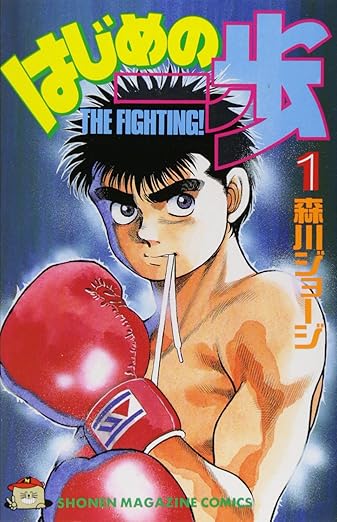
- Genre: Sports
- JLPT Level: N3 & above
- Length: 143 volumes
Hajime no Ippo is about a small high school boy who was often bullied — until he discovered boxing. Even if you’re not a sports fan, this manga (and anime) is incredibly inspiring, with a passion that’s truly contagious. Like Slam Dunk or Haikyu!!, Hajime no Ippo will make you see a sport you knew little about in a whole new light.
The manga is packed with sports and boxing terms, which can be helpful if you want to do combat sports in Japan. Overall, Japanese is not too complicated, and most of the kanji have furigana. It is still ongoing, and there is tons of material for Japanese practice.
7. One Piece (ワンピース)

- Genre: Adventure, Comedy, Action
- JLPT Level: N3 & above
- Length: 112 volumes
One Piece is a manga about the free-spirited Monkey D. Luffy with powers making him as elastic as rubber or ガムガム (gamu gamu). The series almost needs no introduction since anyone can recognize its unique and quirky art that immediately hooks you in. The series’ simple but character-driven plot allows for a story that connects you to everyone you meet and will keep you reading.
The One Piece anime is one of the longest-running anime ever, but the manga is shorter and reads much faster. You will keep getting new material to immerse yourself in, with the added benefit of practicing your Japanese.
8. Detective Conan (名探偵コナン)
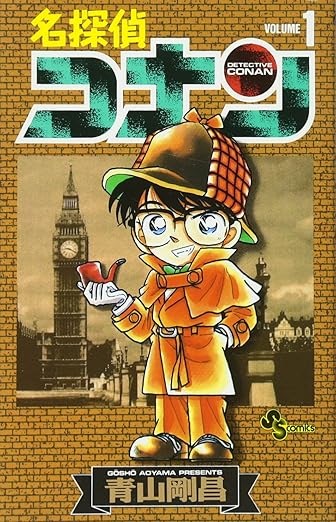
- Genre: Crime, Detective, Mystery, Drama
- JLPT Level: N3 & above
- Length: 107 volumes
Detective Conan is one of the most popular anime and manga series in Japan, and for good reason. The crime cases are riveting. It follows a brilliant high school detective who’s mysteriously turned into a child. As he solves cases in his younger form, he must keep his true identity a secret while chasing the biggest mystery of all.
While manga has a lot of crime and detective-related vocabulary, there is plenty of useful Japanese to pick up for daily life. Even when cases get somewhat complicated, the visuals in the artwork provide enough context to understand what is being described. With the TV show being just as long, learning Japanese with the anime is also great for comprehension practice!
Get Detective Conan Volume 1 on Amazon
Best Manga To Learn Japanese For Advanced Learners
Get ready to jump into stories that don’t hold back in terms of language and kanji. The manga in this list are primarily written for an adult audience, so don’t expect much furigana and expect language that dives into more complex themes.
9. Akira (アキラ)
- Genre: Sci-fi, Cyber-punk
- Length: 6 volumes
- JLPT Level: N2
If you have seen and loved the movie, you should check out the manga since it expands on the world and plot substantially more. Set in a post-apocalyptic, futuristic Tokyo called “Neo-Tokyo”, the story set in the Akira universe plays with motifs of identity, economic inequality, and corruption within the backdrop of cyberpunk aesthetics. Some would argue that Akira is one of the most influential pioneers of the cyberpunk genre!
The story deals with heavy socio-economic, psychological, and philosophical themes, so expect rather high-level Japanese and mature topics. If you haven’t seen the movie, it’s all the more reason to read one of the most influential stories to have ever come from Japan.
10. Vagabond (バガボンド)

Genre: Period, Samurai, Martial arts
Length: 37 volumes
JLPT Level: N2 – N1
In a fictionalized story about the real-life sword master, Musashi Miyamoto, we are taken along a gifted swordman’s journey of growth and self-realization. The artwork is not only beautiful, drawing you in on every panel, but there is a poetic nature to each page and profound lessons we learn through the lens of our protagonist.
The philosophy is just as intriguing as its action scenes since it doesn’t shy away from themes of life & death, morality, and humanity. With that being said, the Japanese will be more complex, using more figurative language and sometimes more archaic terms due to the period setting. This manga is a must-read if you’re an advanced Japanese learner who loves the samurai genre.
Get Vagabond Volume 1 on Amazon
Bonus Manga: A History of Japan (コミック昭和史 Showa)

- Genre: Historical
- Length: 8 volumes
- JLPT Level: N2
This is one for the history buffs. This manga is an autobiography of the author’s experience living through the Showa period, which spans from 1936 to 1989. The author details the daily life of living through World War II, which he tries to show as normal and yet surreal. He highlights this surreal feeling by drawing the main characters in a very cartoonish style, which contrasts sharply with the hyper-realistic depictions of the environments, battleships, and everything related to the war.
This manga is considered by many as a masterpiece in historical literature. It doesn’t hold back in showing the raw emotions and moods of the Japanese during the war. It does dive into rather heavy themes of military power and its implications. The reading level is not extremely complex, but there will be a lot of military, strategy, and political terminology that might be difficult to read. If you want to learn a ton of history and Japanese, this manga should be on your reading list.
Showa: A History of Japan Volume 1
Closing Thoughts On Manga For Learning Japanese
At the end of the day, the best manga for you to learn Japanese is the one you’re the most interested in. Our list is just some of our top picks based on the language and how much we love these stories (in our humble opinion). However, we do recommend starting off at a reading level that matches your current abilities in Japanese.
To get more practice and perhaps reach the level needed to read your favorite manga, take a look at our Coto Academy’s courses. We offer part-time or intensive Japanese lessons!
Want to study Japanese with us?
FAQ
Can you learn Japanese with manga?
Yes, it is possible to learn Japanese with manga. It is normal to feel overwhelmed with the Japanese and to not know all of the language even if you’ve been studying for a while. With manga you can use the artwork to better understand the context of the text, which can actually help you ingrain new terminologies.
Which manga is best for learning Japanese as a complete beginner?
Manga that are written or geared towards children are best for total beginners to learn Japanese. For example, Yotsuba&!, Ao no Hako, Shirokuma Cafe, Flying Witch, and Coro Coro Manga magazine are great for beginners to pick up due to the simpler dialogue.
What level of Japanese would be needed to read most manga?
The level of Japanese would depend on the manga since some have more layered plots and complex themes. However, to read some of the most popular manga, such as One Piece, Naruto, or Bleach, being able to read and comprehend at an N3 level is most recommended to actually understand the story without looking up every other word.
Does Manga have a lot of kanji? Do they have furigana?
Many popular manga like One Piece are shonen, aimed at younger readers, so they include furigana: small hiragana that show how to read the kanji. In contrast, seinen manga for adults usually have little or no furigana, making them harder to read.
